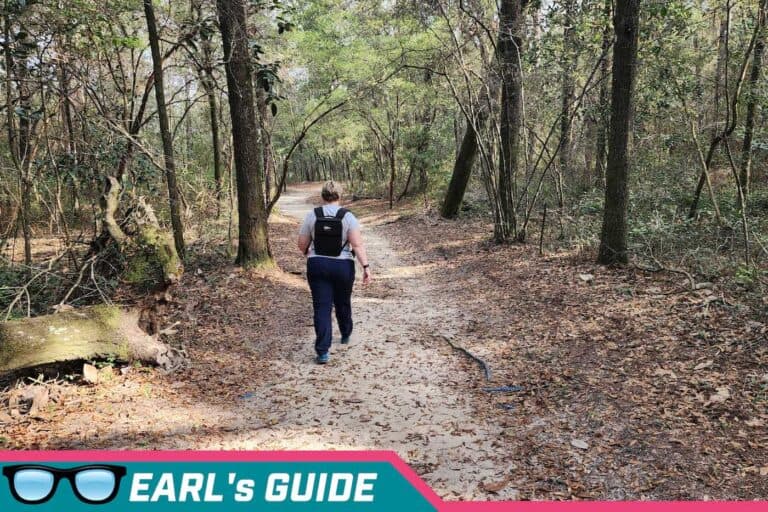Rucking is a form of exercise requiring participants to carry a loaded backpack, also known as a rucksack, for a predetermined distance. As a means of improving one’s strength, endurance, and general fitness level, this particular activity has recently seen a surge in popularity. But can rucking actually help build muscle?
Understanding Muscle Building
The process of gaining muscle is complicated, requiring a combination of resistance training, proper nutrition, and adequate rest. To gain muscle, the body has to be put through a stimulus that forces the muscles to work harder than they are accustomed to accomplishing the task. Because of this, a process known as hypertrophy is initiated, in which the muscle fibers expand and become more robust.
At its most fundamental level, the process of muscle growth or adaptation takes place whenever there is a need for the body to become stronger as a result of an external force. Precisely this is accomplished by the practice of rucking, which involves giving the body resistance through carrying weighted objects and propelling them forward, which places strain on the body’s muscles. If you understand how gaining muscle works, you will be better able to determine whether or not rucking is a practical activity for you to pursue to achieve your goals.
When performed correctly, this type of strength training helps grow muscle in the same way that other forms of resistance training, such as weightlifting and aerobics, do. However, to have the best effects, it is necessary to maintain consistency with the weight carried. This is especially true given that rucking needs longer motions as opposed to the more quick movements that are typical of other forms of exercise. Despite this, numerous studies have shown that performing rucking consistently can help exercisers of all experience levels achieve the benefits they seek when gaining muscle.
The Science Behind Rucking and Developing Muscle
Rucking, which refers to walking while carrying a weight that is strapped to the body, has been popular for a long time among both elite athletes and regular people who are interested in improving their fitness. Rucking has a science behind it, which explains why it is an excellent method of building muscle and burning fat, which many people are unaware of. Rucking engages all of the major muscle groups within a single workout session, which can increase overall muscle mass. Because it lasts for a longer period than the more traditional activities that focus on sprinting, it appears to improve cardiovascular health. In addition, research suggests that regular rucking might raise testosterone levels, which, in turn, can increase strength and bone density. Rucking is one of the most effective strategies to attain general physical fitness goals and specific muscle-building goals because of all these factors.
Rucking offers a unique combination of weight training and cardiovascular exercise, making it an efficient instrument for gaining muscle mass. Rucksacks produce resistance because of the weight that must be carried, which forces the muscles to work harder and ultimately results in hypertrophy. In addition, the cardiovascular component of rucking is an excellent way to burn calories, which contributes to maintaining healthy body composition and supports muscle development.
Rucking’s Effects on Certain Groups of Muscles

Rucking is an excellent full-body exercise that primarily targets the feet and legs. Still, it also works a wide variety of other muscle groups in addition to those two areas. Calves, quads, glutes, hamstrings, abdominals, lats, triceps, and chest are some muscle groups that can be targeted when the exercise is performed correctly. Thanks to the exercises you’ll be doing, you won’t just be improving your cardio endurance, but also your functional strength.
When you go on a rucking expedition, however, you should buy the right boots or shoes because your feet will be subjected to a significant amount of weight when carrying large packs or kettlebells. This form of aerobic exercise is an excellent way to stay in shape and improve your overall health while having fun because, if done correctly, you will notice an increase in power in all of the muscle groups that were mentioned earlier, in addition to toning up throughout each session. This type of aerobic exercise is a fantastic way to have fun while improving your overall health.
Rucking can assist in the development of overall body strength and stability by focusing on the muscle groups mentioned above. Rucking works the quadriceps, hamstrings, glutes, and abdominal and back muscles. Rucking also trains the stabilizing muscles in the hips, knees, and ankles, which can improve posture and lessen the chance of injury. Rucking can be done with a partner or solo.
Rucking’s Correct Form is Extremely Important
Rucking must be performed correctly to avoid injury and maximize the amount of muscle that may be built through the movement. Throughout the rucking exercise, preserving a good posture, keeping the weight close to the body, and engaging the core muscles is essential. Doing so will help ensure that the activity is performed correctly.
Rucking with the proper technique can significantly improve safety, reduce the risk of injury, and efficiently use your time. Ensuring your body is in the ideal posture helps ensure your muscles are correctly engaged, allowing you to get the most out of your workout while avoiding the risk of strain and exhaustion. When moving in any direction, especially while carrying large goods like sandbags or stones, maintaining good form requires maintaining correct posture from head to toe and good hip placement. This is very important.
Rucking can be practiced with correct form and increased strength by beginning with fewer weights during a warm-up session and gradually increasing the weight as time passes. This is a straightforward yet effective method. You can make sure that you get the most out of this full-body workout that increases your physical fitness and mental determination by ensuring that your technique is correct during the entire routine.
The Importance of Food in the Process of Developing Muscle
Because the body needs an appropriate supply of nutrients to assist the process of growing muscle, diet is an extremely important factor in this process. Building muscle and keeping one’s general health in good standing requires consuming a well-rounded diet high in protein, carbs, and healthy fats.
A comprehensive approach is required to achieve toned muscles, one of which is nutrition, which plays a vital role. To achieve your goal of building strong muscles, it is critical to ensure that your daily diet contains adequate levels of protein and a wide variety of vitamins and minerals. Your body will only have the raw resources it needs to construct muscle if you consume the appropriate nutrients.
Muscle development requires a variety of necessary building blocks, many of which can be found in high-quality sources such as lean meats, fish, eggs, nuts, and legumes. Suppose you want to see considerable muscle growth or significant strength improvements. In that case, you need to consume a healthy number of calories proportionate to the intensity of your workouts. A healthy diet helps the body recover from injuries and paves the way for long-term success in achieving fitness goals like increasing strength and growing muscle. When taken as a whole, diet, and exercise are analogous to partners on a dancefloor; to be successful, they need to work in tandem with one another.
The Importance of Rest and Rehabilitation
Because the process of developing muscle occurs during rest rather than during activity, rest and recovery are essential to gaining muscle. It is vital to get enough sleep and rest for the muscles to recuperate and get stronger.
Rest and recovery are two aspects of physical exercise that are sometimes neglected despite their importance. It is vital to incorporate low-intensity workouts such as walking and stretching into your recovery period, even if you have a rigorous training routine planned out for the week. It would be best to give your body sufficient time to relax and recuperate after a long ruck in which a lot of weight was carried across challenging terrain.
Taking the time to recover will promote not only excellent physical health but also good mental health by offering a much-needed respite from the extreme physical strain that has been placed on both the body and the mind. Keeping your muscles active in this way helps keep them from atrophying while leaving them adequate time for repair. In addition, getting sufficient rest will assist in lowering the likelihood of experiencing early weariness during subsequent workouts, which is important for improving overall performance with time.
The advantages of rucking for the development of muscles
Rucking provides various extra benefits in addition to the obvious one of increasing muscular mass. Rucking is a low-impact kind of exercise that is gentle on the joints. Because of this, it is an excellent choice for individuals who suffer from joint pain or have other physical restrictions. Rucking is a terrific approach to increasing general fitness, cardiovascular health, and mood simultaneously.
Rucking is a powerful method of exercise that can be utilized to gain muscle. Walking while carrying a heavy pack, often known as a ruck bag, works more muscles than doing the same activity using only one or two muscles at a time. Because it also causes an increase in heart rate, it might be considered a sort of cardiovascular exercise.
The intensity of the training you are already performing can be enhanced by rucking, which afterward enables you to improve your strength and endurance. In addition, since a rucksack can be carried with relative ease, those who practice it can rapidly alter their workouts as they progress through a training session. This is because the rucksack can be carried with relative ease. Rucking, in the end, offers various advantages for muscle building by providing an opportunity for a workout that is both convenient and efficient for people who participate in it.
Rucking is an excellent complement to any strength training program because of its many advantages and its comparatively low impact. Rucking provides weight training and cardiovascular exercise necessary for effective muscle growth. It is essential to keep perfect form, consume a balanced diet, and allow appropriate rest and recovery time to achieve the most possible muscle-building growth.

Robert Earl
Robert EarlRobert has 20+ years of experience as a Real Estate Agent, Coach, Digital Marketer & Author, coupled with a unique expertise in professional RV Park Management. His time as an RV Park Manager has been marked by a strong ability to increase campground occupancy and revenue through strategic management and targeted marketing efforts. His dual career in online marketing and RV Park Management provides a rich perspective on success in diverse fields. Robert Earl is passionate about teaching and empowering others to pursue their dreams and create sustainable income. Whether through a career in real estate, affiliate marketing, niche blogging, or transforming campgrounds into thriving communities, his proven strategies and techniques have helped numerous individuals and businesses succeed. Based on his years of experience and knowledge in the online marketing industry, along with his hands-on management in the RV Park sector, he has crafted a unique and effective approach to personal and professional growth. In addition to his business pursuits, Robert is also a CrossFit Online Level 1 Trainer (CF-OL1) and enjoys fitness activities, including Rucking workouts while traveling the country. His multifaceted career showcases his dedication to growth, innovation, and the pursuit of excellence in various domains.






